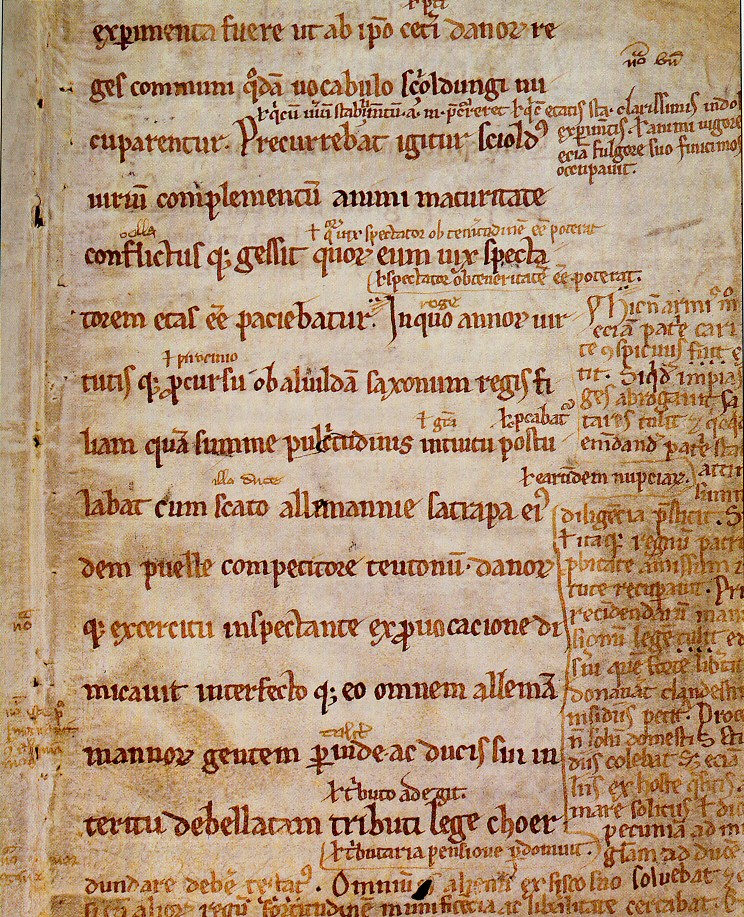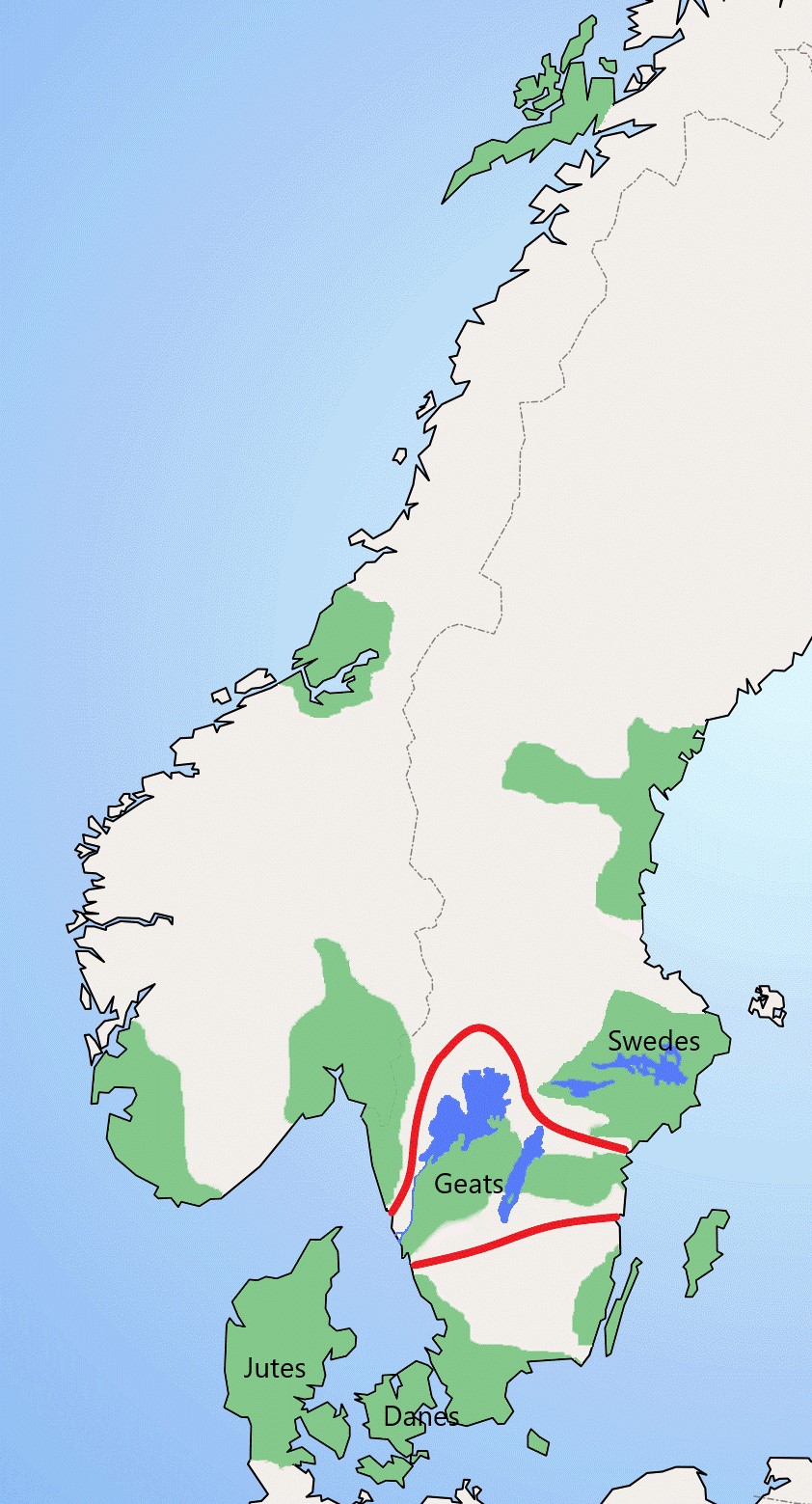|
Erik And Alrik
Alaric and Eric (Old Norse: ''Alrekr'' and ''Eiríkr''), according to legend, were two kings of Sweden. In the ''Ynglinga saga'' According to the ''Ynglinga saga'', Alaric and Eric were sons and heirs of the previous king Agni. They shared the kingship. They were mighty both in war and sport, but were especially skillful horsemen and vied with one another about their horsemanship and their horses. One day they rode off from their retinue and did not return. They were found dead with their heads battered but no weapons with them save the bridle bits of their horses. Accordingly it was believed that they had quarreled and come to blows and had slain each other with their bridle bits. They were succeeded by Alaric's sons Yngvi and Alf. However, in other sources, only Alaric died, and in the piece of Ynglingatal quoted by Snorri Sturluson it is only Alaric who dies explicitly. Eric's death seems to be a misunderstanding on Snorri's part due to an influence from the succeeding king ... [...More Info...] [...Related Items...] OR: [Wikipedia] [Google] [Baidu] [Amazon] |
Gesta Danorum
("Deeds of the Danes") is a patriotic work of Danish history, by the 12th-century author Saxo Grammaticus ("Saxo the Literate", literally "the Grammarian"). It is the most ambitious literary undertaking of medieval Denmark and is an essential source for the nation's early history. It is also one of the oldest known written documents about the history of Estonia and Latvia. Consisting of sixteen books written in Latin on the invitation of Archbishop Absalon, describes Danish history and to some degree Scandinavian history in general, from prehistory to the late 12th century. In addition, offers singular reflections on European affairs in the High Middle Ages from a unique Scandinavian perspective, supplementing what has been handed down by historians from Western and Southern Europe. Books The sixteen books, in prose with an occasional excursion into poetry, can be categorized into two parts: Books 1–9, which deal with Norse mythology and semi-legendary Danish histor ... [...More Info...] [...Related Items...] OR: [Wikipedia] [Google] [Baidu] [Amazon] |
Old Norse
Old Norse, also referred to as Old Nordic or Old Scandinavian, was a stage of development of North Germanic languages, North Germanic dialects before their final divergence into separate Nordic languages. Old Norse was spoken by inhabitants of Scandinavia and their Viking expansion, overseas settlements and chronologically coincides with the Viking Age, the Christianization of Scandinavia, and the consolidation of Scandinavian kingdoms from about the 8th to the 15th centuries. The Proto-Norse language developed into Old Norse by the 8th century, and Old Norse began to develop into the modern North Germanic languages in the mid- to late 14th century, ending the language phase known as Old Norse. These dates, however, are not precise, since written Old Norse is found well into the 15th century. Old Norse was divided into three dialects: Old West Norse (Old West Nordic, often referred to as ''Old Norse''), Old East Norse (Old East Nordic), and Old Gutnish. Old West Norse and O ... [...More Info...] [...Related Items...] OR: [Wikipedia] [Google] [Baidu] [Amazon] |
Skåne
Scania ( ), also known by its native name of Skåne (), is the southernmost of the historical provinces of Sweden, provinces () of Sweden. Located in the south tip of the geographical region of Götaland, the province is roughly conterminous with Skåne County, created in 1997. Like the other historical provinces of Sweden, Scania still features in colloquial speech and in cultural references, and can therefore not be regarded as an archaic concept. Within Scania there are 33 municipalities of Sweden, municipalities that are autonomous within the Skåne Regional Council. Scania's largest urban areas of Sweden, city, Malmö, is the third-largest city in Sweden, as well as the fifth-largest in Scandinavia. To the north, Scania borders the historical provinces of Halland and Småland, to the northeast Blekinge, to the east and south the Baltic Sea, and to the west Öresund. Since 2000, a road and railway bridge, the Öresund Bridge, bridges the Öresund, Sound and connects Scania ... [...More Info...] [...Related Items...] OR: [Wikipedia] [Google] [Baidu] [Amazon] |
Gestumblindi
''Gestumblindi'' is a personal name appearing in two medieval Scandinavian legendary texts: ''Hervarar saga ok Heiðreks'' and (in the Latinised form as ''Gestiblindus'') in Saxo Grammaticus' ''Gesta Danorum''. A figure of this name also appears in several later Scandinavian folk tales as Gest Blinde. Etymology Although generally attested in medieval sources as one word, the name ''Gestumblindi'' in rendered in the U-recension of ''Hervarar saga ok Heiðreks'' as , which means both 'Gestr the Blind' and 'the blind guest'. It is thought that the transparently meaningful is the origin of the name ''Gestumblindi''.Hervarar saga ok Heiðreks''', ed. by Hannah Burrows, in ''Poetry in 'Fornaldarsögur': Part 1'', ed. by Margaret Clunies Ross, Skaldic Poetry of the Scandinavian Middle Ages, 8 (Turnhout: Brepols, 2017), pp. 367–487. The adoption of the name by Óðinn in ''Hervarar saga ok Heiðreks'' is unlikely to be coincidental: 'since the one-eyed Óðinn is celebrated elsewhere no ... [...More Info...] [...Related Items...] OR: [Wikipedia] [Google] [Baidu] [Amazon] |
Gautar
The Geats ( ; ; ; ), sometimes called ''Geats#Goths, Goths'', were a large North Germanic peoples, North Germanic tribe who inhabited ("land of the Geats") in modern southern Sweden from antiquity until the Late Middle Ages. They are one of the progenitor groups of modern Swedes, along with the tribes of Swedes (tribe), Swedes and Gutes. The name of the Geats also lives on in the Provinces of Sweden, Swedish provinces of and , the western and eastern lands of the Geats, and in many other toponyms. The Swedish dialects spoken in the areas that used to be inhabited by Geats form a distinct group, ''Götamål''. Etymology The etymology of the name ''Geat'' (Old English ', from a Proto-Germanic *''Gautaz'', plural *''Gautōz'') is similar to that of ''Goths'' and ''Gutes'' (*''Gutô'', plural *''Gutaniz''). The names derive from Indo-European ablaut, ablaut grades of the Proto-Germanic word *''geutaną'', meaning "to pour". They have the literal meaning "they who pour their se ... [...More Info...] [...Related Items...] OR: [Wikipedia] [Google] [Baidu] [Amazon] |
Gestiblindus
''Gestumblindi'' is a personal name appearing in two medieval Scandinavian legendary texts: ''Hervarar saga ok Heiðreks'' and (in the Latinised form as ''Gestiblindus'') in Saxo Grammaticus' ''Gesta Danorum''. A figure of this name also appears in several later Scandinavian folk tales as Gest Blinde. Etymology Although generally attested in medieval sources as one word, the name ''Gestumblindi'' in rendered in the U-recension of ''Hervarar saga ok Heiðreks'' as , which means both 'Gestr the Blind' and 'the blind guest'. It is thought that the transparently meaningful is the origin of the name ''Gestumblindi''.Hervarar saga ok Heiðreks''', ed. by Hannah Burrows, in ''Poetry in 'Fornaldarsögur': Part 1'', ed. by Margaret Clunies Ross, Skaldic Poetry of the Scandinavian Middle Ages, 8 (Turnhout: Brepols, 2017), pp. 367–487. The adoption of the name by Óðinn in ''Hervarar saga ok Heiðreks'' is unlikely to be coincidental: 'since the one-eyed Óðinn is celebrated elsewhere no ... [...More Info...] [...Related Items...] OR: [Wikipedia] [Google] [Baidu] [Amazon] |


